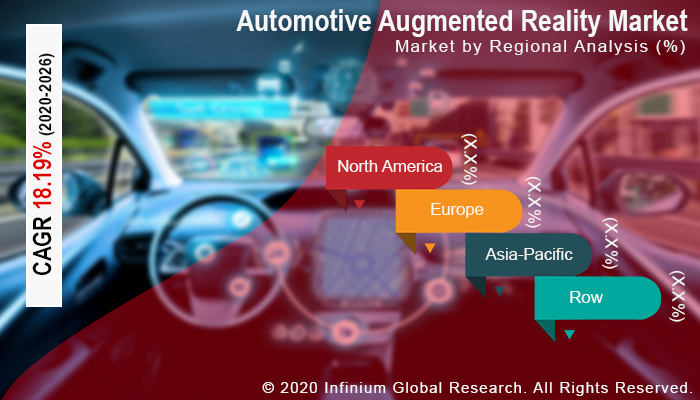Automotive Augmented Reality Market (Sensor Technology - Radar, LiDAR, CCD/CMOS Image Sensors, and Sensor Fusion; Vehicles - Passenger Vehicles, and Commercial Vehicles): Global Industry Analysis, Trends, Size, Share and Forecasts to 2026
A recent report published by
Infinium Global Research on automotive augmented reality market provides
in-depth analysis of segments and sub-segments in the global as well as
regional automotive augmented reality market. The study also highlights the
impact of drivers, restraints, and macro indicators on the global and regional
automotive augmented reality market over the short term as well as long term.
The report is a comprehensive presentation of trends, forecasts, and dollar
values of global automotive augmented reality market. According to the report,
the global automotive augmented reality market is projected to grow at a CAGR
of 18.19% over the forecast period of 2020-2026.
Market Insight
Customers are demanding increased
safety, assistance in navigation, and other technical functions in their cars
to reduce the risk of a human mistake while driving. The development of
windshield augmented reality head-up displays (AR HUDs) is expected to address
all such consumer demands. AR HUDs enhance the driver experience with the help
of see-through displays, and windshield projectors, to give the driver more
information about their surrounding environment, conditions, and vital vehicle
information, without distracting that person from driving. Moreover, augmented
reality combined with computer vision and IoT improve the core of advanced
navigation solutions and ADAS systems. This, in turn, results in enhanced
safety for a driver and contributes to the development of an automotive
connectivity ecosystem.
The growing adoption of connected
vehicles is majorly driving the growth of the market. The connected vehicles
are equipped with the head-up display (HUD) technology that overlays key
information onto the screen in front of the driver, indicating directions and
speed. Furthermore, the rise in awareness regarding road safety is anticipated
to support market growth. A HUD system in combination with AR technology in a
vehicle matches the driving safety information with the information on other
vehicles and pedestrians in the real world and offers the information to the driver
in real-time through a transparent display installed in front of the driver,
fitting the driver's view. However, the concern over cybersecurity due to
vehicle telematics and internet connectivity is hampering the market growth. On
the other hand, the development of 5G technology is expected to boost the
market growth in the future.
In terms of geography, North
America generated the highest revenue in the global automotive augmented
reality market. Strict legal and regulatory standards for driver safety in
motor vehicles in the U.S. and Canada are majorly driving the demand for
automotive augmented reality in North America. Moreover, the increasing demand
for automation and safety in light-duty passenger and heavy-duty passenger
vehicles is anticipated to drive the growth of the automotive augmented reality
market in North America. On the other hand, Asia-Pacific is estimated to be the
fastest-growing region in the global automotive augmented reality market. The
government initiatives to regulate traffic and road accidents are promoting the
growth of automation in automobiles, thus boosting the growth of the automotive
augmented reality market in the Asia-Pacific region.

Segment Covered
The report on global automotive
augmented reality market covers segments such as sensor technology, and
vehicles. On the basis of sensor technology, the sub-markets include radar, LiDAR,
CCD/CMOS image sensors, and sensor fusion. On the basis of vehicles, the
sub-markets include passenger vehicles, and commercial vehicles.
Companies Profiled:
The report provides profiles of
the companies in the market such as Robert Bosch GmbH, Continental AG,
Panasonic Corporation, Visteon Corporation, Denso Corp, Texas Instruments
Incorporated, Garmin Ltd, Honeywell International Inc, Microvision Inc, and others.
Report Highlights:
The report provides deep insights
into the demand forecasts, market trends, and micro and macro indicators. In
addition, this report provides insights into the factors that are driving and
restraining the growth in this market. Moreover, The IGR-Growth Matrix analysis
given in the report brings an insight into the investment areas that existing
or new market players can consider. The report provides insights into the
market using analytical tools such as Porter's five forces analysis and DRO
analysis of automotive augmented reality market. Moreover, the study highlights
current market trends and provides forecast from 2020-2026. We also have
highlighted future trends in the market that will affect the demand during the
forecast period. Moreover, the competitive analysis given in each regional
market brings an insight into the market share of the leading players.
